As The Open approached and Tiger completed one of his best performances in years shooting 7 under at the Greenbrier classic on the PGA tour, hope began to rise in everyone who experienced the era of Tiger Woods. St Andrews has always been a stomping ground for Tiger, a place that brings back fond memories and a course that suits his eye and his game. However as soon as Tiger’s second shot to the first hole finished in the Swilken burn short of the green, that hope and our hearts immediately sank.
Tiger was my idol growing up, and it is amazing to see just how far he has fallen in recent times. Constant swing changes now make him look like he is stuck in a web of technique that he just cannot get out of. Tiger’s body has changed immensely over the years between the gym and injuries, and with that so too has his swing. However those who are Tiger fans still live in hope that he can show us one last flurry or two of the form we had seen in his earlier years.
ADDRESS
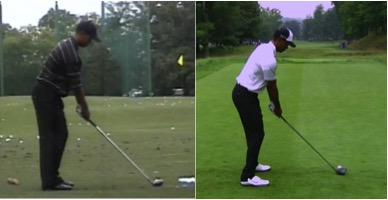
One of the things I have always loved about Tiger is his set up position. It is pretty clear to see his body shape has significantly changed over the last number of years. Aside from the obvious differences of how his shoulders sit to me Tiger appears to have his hips aimed significantly to the left of target in his new set up, compared to his old where everything appears to be almost perfectly in line.
FIRST POSITION
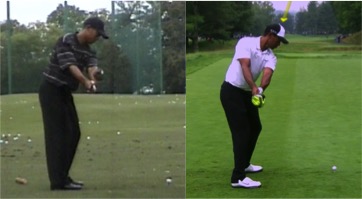
As we look at Tiger’s old takeaway on the left I love the height he begins to get on the club very early in the swing compared to his newer swing on the right hand side. You will also notice that the club face on the left is significantly more open (or vertical) than the one on the right. To me this first position set’s Woods up for everything else that will happen in the swing. I really like his old position as it reduces the chance of the leftward miss which he tends to get quite often.
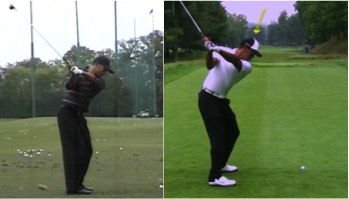
As we begin to get to the top of Tiger’s backswing we start to see some noticeable differences in the positioning of the club. On the left hand side we can see a nice shallow angle with the club pointing towards the golf ball. I love seeing this position with Woods as it means he has very little work to do on the way down which allows him to square the club up with ease. The right hand side you will notice the club is significantly more upright and points inside the ball. The risk with this position is that it increases the chances of woods producing a very steep approach to the golf ball, or else attempting to shallow the club by dropping it behind him.
TOP OF BACKSWING
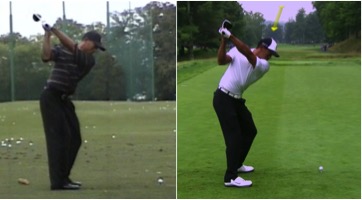
Again as with the previous position we see a couple of significant differences at the top of tigers backswing. In the older image of Tiger the most noticeable difference is the positioning of the club which is almost a touch laid off, and also how relaxed he looks. He has maintained his height quite well and looks relaxed and prepared to make a smooth transition. You will notice on the right hand side the club has reached a slightly longer position and is pointed more towards the target. His hips and lower body look very tightly wound and he has also began to loose quite a bit of height.
THE TRANSITION
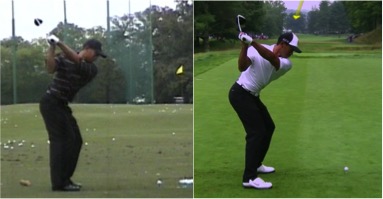
As Tiger begins to start the club down we begin to see the affects of some of his backswing positions. On the left you’ll see a small dip from his head but very little in comparison to the huge squat we see on the right. With his 2000 swing Wood’s has maintained the width of his backswing and sets the club up to approach the ball nicely on its original plane.
HALFWAY DOWN
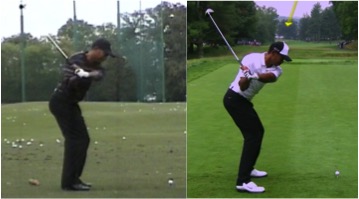
As we mentioned earlier, because of Tiger’s slightly laid off position at the top in 2000, he can simply allow his body to begin turning through the ball and keep his hands and the club on a great plane in front of his body. The image on the right begins to show Tigers club falling behind him and the club face looking a bit more closed than on the left. Again this combination of factors can produce two very different misses, an extreme block to the right or an ugly hook left.
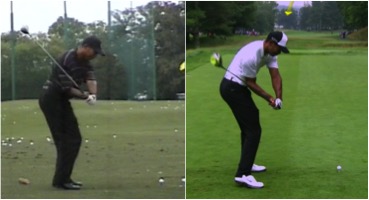
This is a very telling position for Tiger as we can really see how far behind him the club has actually fallen in his 2015 swing (right hand side). If you look at the position of the club relative to his forearms you can see the club is being delivered directly through his forearms in the image on the left where as on the right he has allowed it to fall under his right forearm and create a huge gap between both arms. One other thing which although often missed but is hugely influential to the club face position is his wrist angles. You will notice on the right his wrist appears to be quite bowed which we would often associate with a closed club face, versus the image on the left he seems to have a little more cup which allows the club face to resist closing a little more.
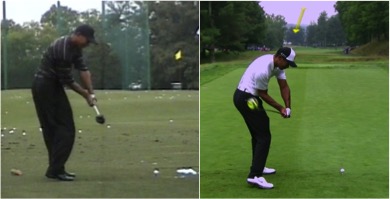
As we approach impact the aforementioned patterns become even more apparent. With his 2000 swing on the left we see the club is far more in front of his body and almost perfectly in line with his hands. The club face is in a more open position (pointing more upright) and to me he has allowed the club to catch up with his body a lot more than on the right. In his 2015 swing on the right Tiger looks like he is struggling to square the club up and allow it to catch his body, he appears to be too far in front of the club and he will really have to work his hands hard through the impact zone. As with previous positions the club is more behind his hands and shut than in 2000.
IMPACT
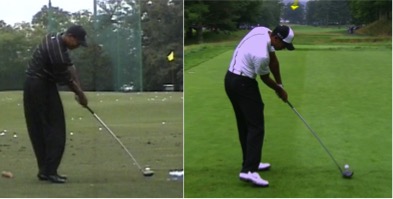
Tiger’s impact in 2000 was almost as good as it gets. He looks relaxed yet athletic and he has allowed the club to square up nicely with his body. Everything looks to be inline and ready to launch the ball towards the target. As we look to his current impact on the right you’ll notice Tiger’s forearms are pointing significantly to the right of the target. This position can be traced back to everything that has happened up to now and caused Tiger to have the club coming from behind his body as opposed to in front of it as he did in the past.
THE RELEASE
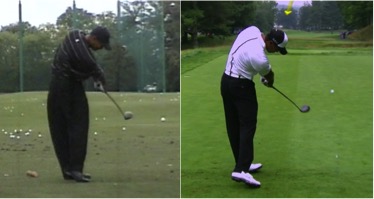
The most amazing thing about Tiger’s release in 2000 is how natural it looked, it never looked as if he was trying to release it a certain way or as if he was fighting with the club, everything looked as if it was in harmony. With his more recent swings it always looks like he is trying to hold the face open and guard against the miss left. In doing this he can often block the ball significantly right of target or double cross himself and hit a smothered hook.
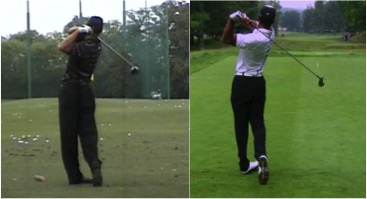
Similar to how he released the club in 2000 Tigers finish looks so relaxed and effortless on the left. The club has freewheeled through the ball and Tiger can watch the ball in a balanced and poised position. If we look at the image on the right you’ll notice his lead foot has moved more than on the left. This could be partially due to the amount of power he now tries to generate through the ball and also the work his body has had to do in the downswing.
Summary and Complete Swing Sequence
All in all Tigers current struggle are pretty obvious. Everyone knows Tiger is older and his body has changed significantly, but I also think it is quite fair to say that there are certain things in his swing that could definitely improve and help lower his scores. Whether he will make those changes or prove me and many other golfing fanatics and critics wrong only time will tell. As a Tiger Woods fan I really hope that this is not how Tigers career ends as in my opinion he is the greatest player that has ever lived regardless as to whether he beats Jack’s records or not.
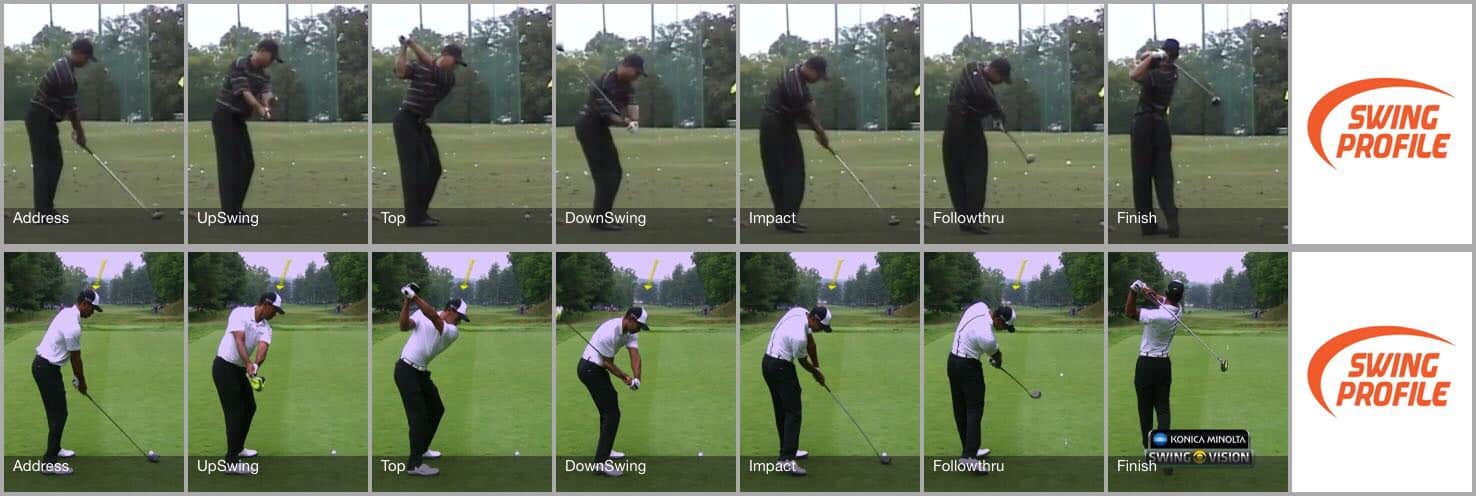
The beautiful Tiger Woods swing sequence on this page is created by Swing Profile golf swing analyzer and training aid. In less than 10 seconds, you can create your own swing sequence too. Watch this video to find out how, then download app to do it for yourself – it’s free!


Think your analysis is spot on despite the two sequences being shot with cameras at clearly different levels from the ground. Interesting how Tiger’s clubface at the top of the move is fairly shut in 2000 and quite square in 2015. Good work though. At some point i think he became determined to produce a fade as his stock ball flight whereas in 2000 he hit high draws. This is likely tied in with the fact he addresses the ball oriented left of his target recently.